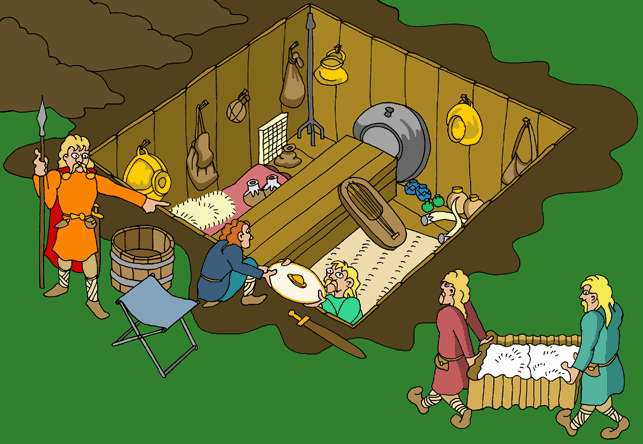|

|
|

Royal Burial Found
in Essex

- In 2003, a 'Royal-style'
Saxon
burial was excavated at a place called Prittlewell, near
Southend, in Essex.
- Warrior burials had been excavated
nearby in the 1930s. So the archaeologists knew there was a
Saxon cemetery there.
- The find was very unexpected
though. The excavators were only there to investigate the area
before a road was widened.
- Like at Sutton
Hoo, the body had dissolved in the acidic soil, but lots of
gold and other expensive possessions remained.
- The dead person seems to have been
a man. He was buried in a coffin in a large wooden room that was
covered by a low mound.
- The room still had pegs on the
walls for hanging up his possessions.
- The man wore a golden buckle which
may have contained Christian holy
relics, and he had small golden foil crosses placed on his
body. But he also had gold coins to pay the pagan
ferryman to take him to an afterlife.
- The man was surrounded by lots of
things to take with him:
- Rare blue and green glass
jars
- Wooden bottles with gold
decoration
- A bronze 'Coptic' bowl from
Egypt
- A bronze flagon from Persia or
North Africa
- A folding stool (or throne) from Italy or
Hungary
- He must have been planning on doing
a lot of feasting!
- Look at the picture. Can you see
any items like those found at Sutton Hoo?
- Like at Sutton Hoo, the expensive
objects from great distances make archaeologists think the dead
man was a king.
- The coins, buckle, jars and bowl
date from AD 600 to 640.
- So the dead King could have been King
Saebert of Essex.
- He was a pagan who was converted to
Christianity by St. Mellitus, a friend of St.
Augustine.
- He reigned from AD 604 to 617.
- Activity
Sheet available.
|

